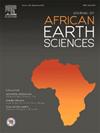在埃及Wadi al - assity,三维反演磁数据来描绘控制地下水补给和排放的地下结构
IF 2.2
4区 地球科学
Q2 GEOSCIENCES, MULTIDISCIPLINARY
引用次数: 0
摘要
本研究旨在加强我们对瓦迪阿西地区地下水积累的了解,重点是支持新城市住区和国家工业倡议的发展。为了实现这一目标,对航空磁数据进行了处理和分析,从而能够描绘地下结构及其对地下水流动模式的影响。该研究还旨在评估该地区含水层的厚度。基于卫星的数字高程数据被解释为绘制主要排水模式,突出显示地表水倾向积聚的流域和盆地。此外,利用航空磁资料对努比亚含水层的沉积覆盖层进行探测,并对其厚度分布进行评价,最终确定了厚度最大、地下水储量潜力最大的最有潜力含水层。磁数据分析采用了三种主要技术。首先,采用源边缘检测方法识别不同磁强异常源;其次,计算基底面深度,对应研究区努比亚含水层基底;第三,利用三维磁数据反演建立基底岩石的三维模型,帮助确定深水井的最佳钻井位置。总体目标是确定具有强大地下水勘探潜力的地区,这对埃及的可持续发展至关重要。为了确保准确性,结果受到先前地质、地球物理和钻井数据的限制。Wadi Al-Assiuty是埃及的一条主要河流,呈矩形水系(角状溪流),穿插着亚树枝状到亚平行的子盆地,反映了水系网络的构造控制。通过线性变换和基于导数的技术生成的结果图显示,NW-SE和E-W断层系统在控制地表径流水、深层努比亚砂岩含水层和尼罗河含水层的补给方面发挥了重要作用。值得注意的是,地下室的深度变化很大,从地表以下200米到4800米不等。这项研究与埃及2030年可持续发展计划相一致,特别关注有前途的沙漠地区,这些地区可以转变为农业开发区。本文章由计算机程序翻译,如有差异,请以英文原文为准。
3D inversion of magnetic data to delineate subsurface structures controlling groundwater recharge and discharge at Wadi Al-Assiuty, Egypt
This study aims to enhance our understanding of groundwater accumulations in the Wadi Al-Assiuty region, with an emphasis on supporting the development of new urban settlements and national industrial initiatives. To achieve this objective, airborne magnetic data were processed and analyzed, enabling the delineating the subsurface structures and their impact on groundwater flow patterns. The research also aimed to assess the aquifer’s thickness within the area. Satellite-based digital elevation data were interpreted to map the primary drainage patterns, highlighting watersheds and basins where surface water tends to accumulate. Additionally, aerial magnetic data were employed to detect the sedimentary cover and evaluate the thickness distribution of the Nubian aquifer, ultimately identifying the most promising aquifer with the highest thickness and greatest potential groundwater reserves.
The magnetic data analysis employed three primary techniques. First, source edge detection was applied to identify sources with varying magnetic intensity anomalies. Second, the depth of the basement surface was calculated, corresponding to the base of the Nubian aquifer in the study area. Third, 3D magnetic data inversion was used to create a three-dimensional model of the basement rocks, aiding in the identification of optimal locations for drilling deep groundwater wells. The overarching goal is to locate areas with strong groundwater exploration potential, which is critical for Egypt’s sustainable development. To ensure accuracy, the results are constrained by incorporating previous geological, geophysical, and drilled wells data.
Wadi Al-Assiuty, a major Egyptian wadi, exhibits a rectangular drainage pattern (angular streams) interspersed with sub-dendritic to subparallel sub-basins, which reflects the structural control of the stream network. The resulting maps, generated through linear transformations and derivative-based techniques, reveal that NW-SE and E-W fault systems play a significant role in controlling the recharge of the aquifers from surface run-off water, the deep Nubian sandstone aquifer, and the Nile River. Notably, the depth to the basement varies widely, ranging from 200 m to 4800 m below the surface. This study aligns with Egypt’s 2030 sustainable development plan, particularly focusing on promising desert areas that could be transformed into agricultural development zones.
求助全文
通过发布文献求助,成功后即可免费获取论文全文。
去求助
来源期刊

Journal of African Earth Sciences
地学-地球科学综合
CiteScore
4.70
自引率
4.30%
发文量
240
审稿时长
12 months
期刊介绍:
The Journal of African Earth Sciences sees itself as the prime geological journal for all aspects of the Earth Sciences about the African plate. Papers dealing with peripheral areas are welcome if they demonstrate a tight link with Africa.
The Journal publishes high quality, peer-reviewed scientific papers. It is devoted primarily to research papers but short communications relating to new developments of broad interest, reviews and book reviews will also be considered. Papers must have international appeal and should present work of more regional than local significance and dealing with well identified and justified scientific questions. Specialised technical papers, analytical or exploration reports must be avoided. Papers on applied geology should preferably be linked to such core disciplines and must be addressed to a more general geoscientific audience.
 求助内容:
求助内容: 应助结果提醒方式:
应助结果提醒方式:


